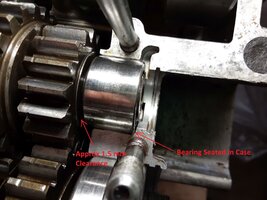dps650rider
XS650 Addict
I'm putting one of my engines together and I am hoping someone can answer a question I have long had regarding the positioning of the 2 roller bearings on the transmission shafts. When setting the transmission shafts in the case the roller bearings can be moved back and forth quite a bit, I measured about 1.5 mm on the input shaft. What I have always done is to set the roller bearing so it has a small gap next to the gear (or circlip on the output shaft) and a much larger gap toward the case knowing that as the engine heats up the clearance between the gear and the bearing will increase.
Honestly I don't think this matters since the ball bearings determine the positions of the shafts. There is nothing mentioned about this in the service manuals and I have always wondered if there is a "correct" way of doing this.
Honestly I don't think this matters since the ball bearings determine the positions of the shafts. There is nothing mentioned about this in the service manuals and I have always wondered if there is a "correct" way of doing this.

